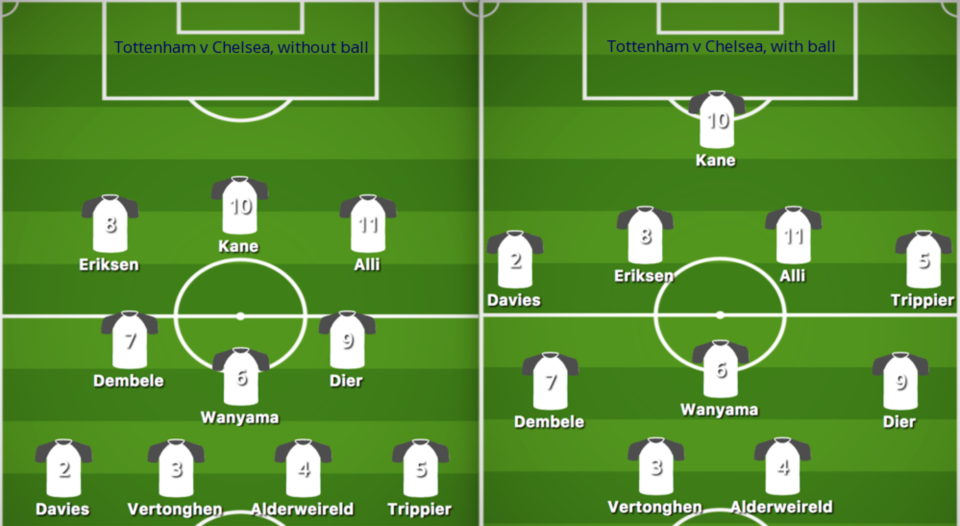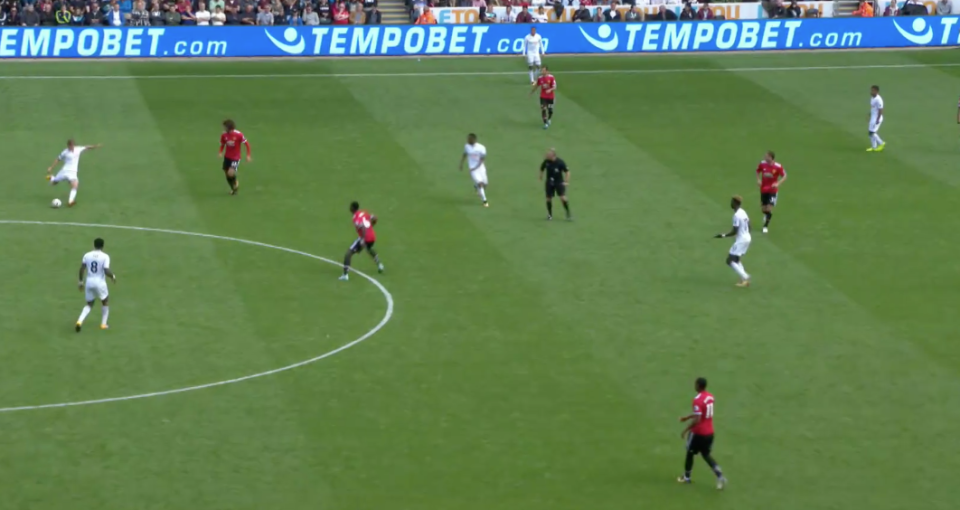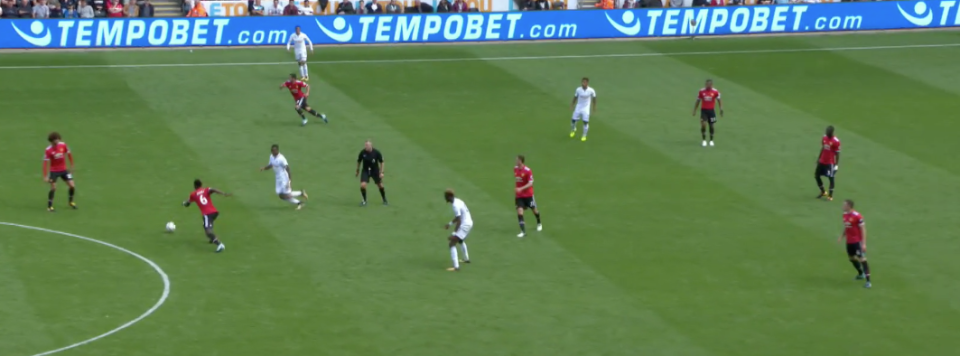2017-18 Premier League DARTS: Chelsea-Spurs, Man United's counter, and Arsenal's complaints

Welcome to Premier League DARTS, FC Yahoo‘s weekly EPL column that will run every Monday morning. Why “DARTS”? Because Henry Bushnell will recap the weekend’s biggest games with Discussion, Analysis, Reactions, Takeaways and Superlatives. All of that is below. But first, a brief intro …
He punched the air not once, not twice, but three times. And not with one fist; with both. And then he spun and sped toward his assistants, hair flopping, arms flailing, emotions fuming. But fuming in delight, instead of fuming with anger. His left wing-back had just stunned 80,000-plus at Wembley, and Antonio Conte could not contain himself. No chance. He knew what this meant, knew the context, knew the narrative, knew it had to change.
And so he ditched his royal blue tracksuit for a jacket and tie, put his faith in eight defensive-minded outfield players, and got his reward. He and Chelsea did what champions do. They nicked all three points from an evenly contested match at the (temporary) home of a rival, and in doing so won the second weekend of the Premier League’s 2017-18 season.
Just as last week didn’t spell disaster, Sunday didn’t quell all concerns. Marcos Alonso might not bag another brace the rest of his career. Chelsea’s attack hasn’t yet shown it can match the potency of last year’s, and the squad’s shallowness hasn’t been solved overnight. In fact, there aren’t too many takeaways from the weekend’s one true heavyweight battle.
But there is a recognition – among supporters, among players, and clearly within Conte himself – of just how crucial the result was for Chelsea. It took steel and grit, shrewd management, and a little bit of luck, too. Remember all that come May.
1. The shortcomings of Tottenham’s attack
The champions limited their London rivals to <1 expected goals with a formation that, without the ball, could most accurately be described as a 5-3-1-1. Tottenham boss Mauricio Pochettino surely anticipated Chelsea’s defensive approach, and combated it with a twist on his typical tactics.
Pochettino named a starting 11 that could have lined up in a 3-4-3, 4-2-3-1, 4-3-3, or really any three- or four-at-the-back variation. What it ultimately was, until Spurs went chasing the game late, was a 4-3-2-1 without the ball that morphed into a 4-1-4-1 with it. How, exactly?

Pochettino essentially played Kieran Trippier and Ben Davies as wing-backs in a four-man defense. In attack, they were the wingers in what could even be thought of as a 4-3-3, with Dele Alli and Christian Eriksen the attacking midfielders and Wanyama holding. Especially on the right side, Dier became a distributing fullback. Dembele dropped left at times as well.
Both diagrams are rough estimates. In reality, Dembele, Eriksen and Alli all had a fair amount of freedom when Spurs were in possession. And to be fair to Spurs, those three, plus Kane, created a decent amount considering the solidity of their opponents. The xG total is a bit harsh. Structurally, you could argue the system worked.
The problem is that neither Trippier nor Davies is a winger. Both are out-and-out fullbacks, and simply giving them more attacking leeway doesn’t give them more attacking talent.
They also, of course, were not Tottenham’s first-choice fullbacks a month ago, and might not be a month from now. If Kyle Walker and Danny Rose had been in their places — or if a new signing or two had supplanted one or both in the starting 11 – you have to wonder if Sunday’s result would have been different. Food for thought for Pochettino.
2. The anatomy of Manchester United’s counters
There is hardly anything more breathtaking in soccer than a sweeping, end-to-end counterattack, and there has been no better sweeping, end-to-end counterattack through two weeks of the Premier league season than Man United’s. Three of its eight goals have come on the break. And while each of the three has been unique, there are several threads through all three that show just how devastating Jose Mourinho’s team can be.
The clearest example was United’s third of four goals Saturday at Swansea. Whereas early in the match Swansea sat back and United took the initiative, by the 80th minute, the weight of the game had shifted. United had 10 players behind the ball when Tom Carroll pick his head up and spotted what he thought was a passing lane:

Paul Pogba, though, spotted exactly the same lane. And when he stepped into it to cut out Carroll’s pass, United was immediately off and running. Mkhitaryan (top of the frame) had positioned himself to react to any Carroll pass in either a defensive or offensive manner, and right when possession changed hands, he instantly broke forward:

As much as the intricacies and final passes of counters matter, effort and reaction time matter so much. United’s players have surely been taught to recognize counterattacking opportunity, and that’s why Mkhitaryan’s quick-trigger burst forward seems so intuitive.
His burst and commitment are the reasons he and United essentially turned a 3-v-5 into a 2-v-2. The speed at which he broke allowed him to cut his run underneath the recovery run of Carroll and place all but two Swansea defenders behind the play:

And then Pogba’s dead sprint – 22 strides, five seconds, from his own half into the penalty area – turned a 2-v-2 into a 3-v-2. Again, effort makes a huge difference.
The goal doesn’t happen without Pogba, nor without Mkhitaryan. That much is clear upon first viewing. But it also isn’t possible without Romelu Lukaku and a keen sense of counterattack spacing.
As Mkhitaryan dipped infield, the big Belgian striker had a choice to make. He easily could have made a similar run to Pogba’s, against the grain to the near side of the box. He might even have been able to latch onto the exact ball that Mkhitaryan eventually played.
Instead, though, Lukaku stayed in his lane. He drifted toward the far post, pulling one of Swansea’s defenders with him, and allowing United to take advantage of what Pogba turned into a 3-v-2. Perhaps Lukaku just blindly guessed right. But more likely than not, he sensed that Pogba had a full head of steam, and knew not to encroach on the space his mate eventually ran into.
Not every player who contributes to a counter must touch the ball. United has been so devastating in part because its players understand that, and because they understand the spacing that spreads an opponent thin. And once they understand that?
“Just let the horses run freely,” Mourinho said with a chuckle in his postmatch interview. “And they were magnificent.”
3. The Coutinho-sized hole in Liverpool
Whereas United has stomped two lesser opponents, Liverpool has labored through 180 minutes against similar foes. And while a season-opening 3-3 draw at Watford wasn’t really connected to prior issues against the bottom half of the league, a 1-0 victory over Crystal Palace typified many of them. The Reds took three points, but needed a touch of good fortune to bail out a stagnant attack.
And that stagnant attack is inextricably linked to the Philippe Coutinho transfer saga, which remains in limbo. It’s not that playing without Coutinho is a completely foreign concept for Liverpool, but the diminutive Brazilian is precisely the type of player who unlocks defenses like Palace’s. He scored or assisted on 20 goals against decidedly inferior opponents last season. His vision, long-range shooting and slithery dribbling are necessities in games like Saturday’s.
We’ll spare you the video evidence, which is minutes upon minutes of slow buildup play and uninventive passes, because Liverpool’s attacking efforts without Coutinho were not easy on the eye. James Milner played as the most advanced of three midfielders. Roberto Firmino, Sadio Mané and Daniel Sturridge comprised the attack. Combinations between the four of them were not plentiful.
In Coutinho’s absence, it was Mané who dropped deep on the left side in an attempt to jumpstart attacks. Here was his 78-touch heat map, via WhoScored.com:

And here was the entire team’s:

Mané is Liverpool’s best healthy player, and the goal ultimately came from an attack he started on the left. But Jurgen Klopp’s sans-Coutinho problem is that casting Mané in a deeper creative role – essentially the Coutinho role – doesn’t take full advantage of his talents. So the Reds don’t just miss Coutinho, they miss the full extent of Mané’s threat.
Liverpool wasn’t only without Coutinho. Klopp kept Mo Salah on the bench to start, and that could help explain the unbalanced attack. Plus, statistically, it was just fine. On the day, it was good enough.
But the xG output was somewhat deceiving. There was a Coutinho-sized hole in the approach play. How big the hole is, and how fillable it is, are the big questions. Klopp and his back-room staff will be doing an extensive review of Saturday, and their takeaways might help determine how willing they are to sign off on a sale of Coutinho to Barcelona.
4. Aaron Mooy and the modern No. 10
One of the overarching tactical evolutions in modern soccer has been the phasing out of the classic No. 10. One-dimensional players have fallen by the wayside, replaced by versatility and multi-functionality. That’s not to say every top-flight footballer must be an adept attacker and defender, but especially in non-elite teams, two-way players are vital. And, outside the Premier League’s top six, there has been no better two-way player through two weeks than Huddersfield Town’s Aaron Mooy.
Mooy, an Australian midfielder purchased from Manchester City this summer, scored the goal that clinched Huddersfield its second win in two games:
But he also tackles like this:

And tracks back like this (top of the screen):

Get yourself a No. 10 who can do it all.
5. The flaw in Arsenal’s main complaint
Anybody remotely fond of or acquainted with Arsenal was fuming on Saturday when the Gunners were seemingly robbed of at least a draw at Stoke. They pointed to Mame Biram Diouf’s challenge on Hector Bellerin, and to several other penalty area incidents. But the main subject of their ire was a 72nd-minute offside decision that ruled out what appeared to be a perfectly legal Alexandre Lacazette goal. Fans howled: He’s clearly level!
Here’s the thing, though: He’s not.

Or maybe he is level. But he’s not onside.
Yes, there’s a difference. It’s the difference between the spirit of the offside law and the letter of it. The law was not implemented to prevent a goal like Lacazette’s. Lacazette, by any non-technical definition, was level with Eric Pieters. But the law is what it is, and it states that if “any part of the head, body or feet is nearer to the opponents’ goal line than both the ball and the second-last opponent“ – allowing further for the fact “the hands and arms of all players are not considered“ – then a player is in an offside position. Now go back to the above picture and try to argue Lacazette isn’t offside.
But don’t try to argue that the spirit of the law should trump the wording of it, because that’s not how soccer works. And if it were, there would be endless gray areas. If it were, and if Lacazette were two inches farther upfield, would the spirit of the law still apply? What if he crept another two inches forward? And another two? When does a player go from “basically level” or “level enough” to “not level enough”?
You get the point. It’s not feasible to selectively enforce the rule based on a subjective reading of its intent. Were Lacazette and Arsenal unlucky to see the goal ruled out? Yeah. Absolutely. But not because the ref erred.
6. Top #Banter of the week
apologies for the delay in replying. We've been busy looking for a missing person, surname Ozil. Have you seen him? #Banter
— Stoke Police (@policingstoke) August 20, 2017
7. Stat of the week
There was never a suggestion that Burnley v West Brom was going to be a stylish, open flowing game. But just over 47 minutes play……… pic.twitter.com/jAn8ybFfaJ
— Colin Trainor (@colintrainor) August 20, 2017
8. Intrigue-ometer
On a scale of 1-10, with 1 representing a complete lack of interest and 10 representing utter fascination, how intrigued are we by…
West Brom? — 1
Huddersfield? — 4
Watford? — 8
9. Worry-ometer
On a scale of 1-10, with 1 representing a complete lack of concern and 10 representing a freakout, how worried are we about…
West Ham? — 2
Bournemouth? — 3
Crystal Palace? — 3
Brighton? — 5
Newcastle? — 5
Swansea? — 6
SPURS AT WEMBLEY? — 1
– – – – – – –
Henry Bushnell covers soccer – the U.S. national teams, the Premier League, and much, much more – for FC Yahoo and Yahoo Sports. Have a tip? Question? Comment? Email him at henrydbushnell@gmail.com or follow him on Twitter @HenryBushnell.



